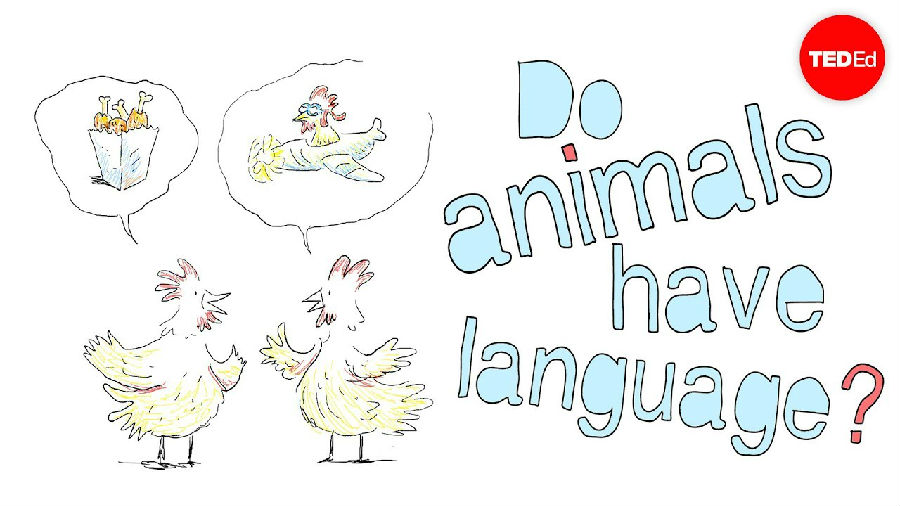(单词翻译:单击)
All animals communicate. Crabs wave their claws at each other to signal that they're healthy and ready to mate.
所有的动物都会相互交流。螃蟹相互间挥舞钳子表明它们健康并准备交配。
Cuttlefish use pigmented skin cells called chromatophores
乌贼使用叫色素体的皮肤色素细胞,
to create patterns on their skin that act as camouflage or warnings to rivals.
在它们的皮肤上创造图案形成伪装,用来迷惑或警示敌人。
Honeybees perform complex dances to let other bees know the location and quality of a food source.
蜜蜂通过表演复杂的舞蹈来让其他的蜜蜂知道食物源的位置和质量。
All of these animals have impressive communication systems, but do they have language?
所有的动物都有一流的交流系统,但它们有语言吗?
To answer that question, we can look at four specific qualities that are often associated with language:
为了回答这个问题,我们来看下跟语言相关的4个特质:
discreteness, grammar, productivity, and displacement.
分离性,语法性,创造性和时空性。
Discreteness means that there is a set of individual units, such as sounds or words,
分离性是指一组独立的单元,比如声音或者词语,
that can be combined to communicate new ideas,
能够被组合在一起传达新的想法,
like a set of refrigerator poetry magnets you can rearrange to create different phrases.
就像贴在冰箱门上的诗词磁条可以通过重组来创建不同的词汇。
Grammar provides a system of rules that tells you how to combine those individual units.
语法性提供了一套规则,让你知道如何组合那些独立单元。
Productivity is the ability to use language to create an infinite number of messages.
创造性是运用语言来创造无限量信息的能力。
And displacement is the ability to talk about things that aren't right in front of you,
时空性是谈论那些不在眼前事物,
such as past, future, or fictional events.
比如过去,未来或者虚构事件。
So, does animal communication exhibit any of these qualities?
那么,这些动物交流时会展现出其中任何的特质吗?
For crabs and cuttlefish, the answer is no.
就螃蟹和乌贼而言,答案是不会。
They don't combine their signals in creative ways.
它们不会以创新的方式来衔接这些信号。
Those signals also don't have to be in a grammatical order,
那些信号没有必要按照语法的顺序排列,
and they only communicate current conditions, like, 'I am healthy,' or 'I am poisonous.'
它们只交流现状,比如,“我很健康”,或者“我有毒”。
But some animals actually do display some of these properties.
但有一些动物们会展现出这些特性。
Bees use the moves, angle, duration, and intensity of their waggle dance to describe the location and richness of a food source.
蜜蜂们在舞蹈中通过摇摆舞的位置变动,角度,时长和强度来描述食物源的位置和富裕程度。
That source is outside the hive, so they exhibit the property of displacement.
食物源位于蜂巢之外,所以它们展现出了时空性。
They share that language trait with prairie dogs, which live in towns of thousands,
它们分享了跟土拨鼠一样的语言特征,土拨鼠住在数千个城镇中,
and are hunted by coyotes, hawks, badgers, snakes, and humans.
是土狼,老鹰, 獾,蛇和人类的猎物。
Their alarms calls indicate the predator's size, shape, speed,
它们的警报展现了捕猎者的大小,体型,速度,
and, even for human predators, what the person is wearing and if he's carrying a gun.
甚至包括人类狩猎者的穿着以及是否带着枪。
Great apes, like chimps and gorillas, are great communicators, too.
类人猿,比如黑猩猩和大猩猩,也很善于交流。
Some have even learned a modified sign language.
甚至有一些学会了改进后的手语。

A chimpanzee named Washoe demonstrated discreteness by combining multiple signs into original phrases, like, 'Please open. Hurry.'
一只名叫Washoe的黑猩猩,通过将不同的手势转换成原始的词组,展现了其分立性,像“快打开门”。
Coco, a female gorilla who understands more than 1000 signs,
Coco,一只能明白1000多种手势
and around 2000 words of spoken English referred to a beloved kitten that had died.
和大约2000个英语口语词汇的雌猩猩,提到了一只刚死去的可爱小花猫。
In doing so, she displayed displacement,
她的这种表现显示出了时空性,
though it's worth noting that the apes in both of these examples were using a human communication system,
但值得注意的是类人猿在这两个案例中用的是人类的交流体系,
not one that appeared naturally in the wild.
而并不是任何天然形成的特性。
There are many other examples of sophisticated animal communication,
动物们还有很多复杂交流的案例,
such as in dolphins, which use whistles to identify age, location, names, and gender.
比如海豚,通过吹口哨来辨别年龄,位置,姓名和性别。
They can also understand some grammar in a gestural language researchers use to communicate with them.
它们也懂一些研究人员用来与之交流的语法。
However, grammar is not seen in the dolphin's natural communication.
然而,在海豚的自然交流中是不存在语法的。
While these communication systems may have some of the qualities of language we've identified, none display all four.
虽然这些交流体系中会体现出一些我们所知的语言特性,但并不包含全部四个。
Even Washoe and Coco's impressive abilities are still outpaced by the language skills of most three-year-old humans.
即便Washoe和Coco拥有一流的语言能力,也不如大多数3岁孩子的语言技巧。
And animals' topics of conversation are usually limited.
动物们对话的内容通常都很有限。
Bees talk about food, prairie dogs talk about predators, and crabs talk about themselves.
蜜蜂谈论食物,土拨鼠讨论捕食者,螃蟹讨论它们自己。
Human language stands alone due to the powerful combination of grammar and productivity, on top of discreteness and displacement.
人类的语言就显得独树一帜了,这源于对语法和创造性的强大组合能力和领先的分离性和时空性。
The human brain can take a finite number of elements and create an infinite number of messages.
人类的大脑能够利用有限的元素创造无限量的信息。
We can craft and understand complex sentences, as well as words that have never been spoken before.
我们能够加工和理解复杂的句式,以及我们从没说过的词语。
We can use language to communicate about an endless range of subjects, talk about imaginary things, and even lie.
我们能运用语言交流无限量的主题,讨论想象的事物,甚至说谎。
Research continues to reveal more and more about animal communication.
研究还在不断揭露更多的关于动物交流的信息。
It may turn out that human language and animal communication aren't entirely different but exist on a continuum.
或许能证明人类的语言和动物的交流并非完全不同,而是存在于同一个交集区。
After all, we are all animals.
毕竟,我们都是动物。


